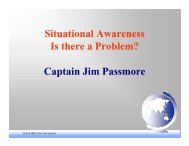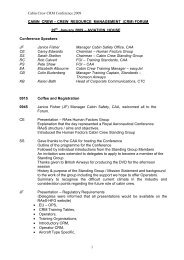Culture, Error, and Crew Resource Management - Human Factors ...
Culture, Error, and Crew Resource Management - Human Factors ...
Culture, Error, and Crew Resource Management - Human Factors ...
You also want an ePaper? Increase the reach of your titles
YUMPU automatically turns print PDFs into web optimized ePapers that Google loves.
<strong>Culture</strong>, <strong>Error</strong>, <strong>and</strong> CRM 3<br />
<strong>Human</strong> error is inevitable, so when an error occurs (whether committed by an external agent or by the<br />
crew), it is the crew’s task to detect <strong>and</strong> respond to the error. The behaviors of effective error detection <strong>and</strong><br />
management are best illustrated by cross-checking <strong>and</strong> verifying actions, evaluating the quality of decisions made,<br />
etc. When errors are not detected or corrected, the level of risk for a flight is increased.<br />
This model does not represent a significant departure from the original training programs that were called<br />
Cockpit <strong>Resource</strong> <strong>Management</strong> in the early 1980s. First generation CRM was developed in response to NASA<br />
findings that ‘pilot error’ was involved in the majority of air crashes <strong>and</strong> was seen as a method to reduce such error<br />
(Cooper, White, & Lauber, 1980). However, the linkage between early curricula <strong>and</strong> pilot error was unclear <strong>and</strong>,<br />
with the passage of time, the goals of CRM appear to have become lost on many participants in the training<br />
(Helmreich, Merritt, & Wilhelm, 1999). The purpose of our model is to re-establish the basic goals of CRM. 3 We<br />
also recognize that, in order to implement CRM optimally, the cultural context of flight operations needs to be<br />
considered.<br />
<strong>Culture</strong> <strong>and</strong> Safety<br />
In aviation, the three cultures, professional, organizational, <strong>and</strong> national, can have both positive <strong>and</strong><br />
negative impact on the probability of safe flight. Safe flight is the positive outcome of timely risk recognition <strong>and</strong><br />
effective error management, which are universally desired outcomes. The responsibility of organizations is to<br />
minimize the negative components of each type of culture while emphasizing the positive. Both CRM <strong>and</strong> technical<br />
training form part of an error management philosophy <strong>and</strong> program.<br />
Professional <strong>Culture</strong> <strong>and</strong> its Manifestations<br />
Although we recognized the existence of <strong>and</strong> some of the manifestations of the professional culture of pilots<br />
early in our investigations of flight crew behavior <strong>and</strong> attitudes, we did not immediately underst<strong>and</strong> its potency as an<br />
influence on safety. In retrospect, the roots of a strong professional culture are clear—early aviation was an extremely<br />
dangerous undertaking, for those in combat, carrying the mail, or stunt flying for awed audiences. To commit to such<br />
a hare-brained endeavor required a strong sense of personal invulnerability <strong>and</strong> efficacy. The respect <strong>and</strong> envy<br />
engendered among generations of adolescents also fostered pride in being one of “the few”, to borrow Churchill’s<br />
description of Spitfire pilots during the Battle of Britain. This image of personal disregard for danger <strong>and</strong><br />
invulnerability reached its zenith with the early astronauts (all chosen from the ranks of test pilots) <strong>and</strong> was<br />
immortalized by Tom Wolfe in The Right Stuff (1979).<br />
When we began systematically assessing pilots’ attitudes about their jobs <strong>and</strong> personal capabilities, we<br />
found that the ‘pilot culture’ showed great consistency among more than fifteen thous<strong>and</strong> pilots in over twenty<br />
countries (Helmreich & Merritt, 1998). What distinguished pilots on the positive side was an overwhelming liking<br />
for their job. Pilots are proud of what they do <strong>and</strong> retain their love of the work. Figure 2 shows the responses of pilots<br />
from 19 countries to the stem “I like my job.” On a 5-point scale where 1 is disagree strongly <strong>and</strong> 5 is agree strongly,<br />
no group had a mean below 4.5 <strong>and</strong> several had means over 4.9. 4<br />
3 The definition of CRM in the opening chapter of a 1993 book on CRM did not mention error but described it as<br />
the process of ‘optimizing not only the person-machine interface <strong>and</strong> the acquisition of timely, appropriate<br />
information, but also interpersonal activities including leadership, effective team formation <strong>and</strong> maintenance,<br />
problem-solving, decision making, <strong>and</strong> maintaining situation awareness’ (Helmreich & Foushee, 1993, p. 3).<br />
4 Liking for the profession is independent of attitudes about one’s organization. Some of those most enthusiastic<br />
about their profession expressed passionate dislike for the organization <strong>and</strong> indicated that morale was abysmal in<br />
their airline.




